Upma Recipe
Updated: June 27, 2024, By Swasthi
Upma is a popular South Indian breakfast made with semolina, curry leaves, green chilies, vegetables, lentils and tempering spices like mustard seeds. It is aromatic, delicious, filling and a fast dish that you can whip up under 20 mins. In this post I share the traditional method to make fluffy, non-sticky and moist rava upma.
Also known as uppittu, it is a staple in the South Indian homes and restaurants. It is usually eaten on its own with a squeeze of lemon juice, or with pickle, podi or coconut chutney. Elsewhere on the streets, it is also served with a garnish of sev or farsan. For young kids, a lot of people sprinkle some sugar to tone-down the heat.
Did you ever wonder how the Upma served in some restaurants and wedding places is so delicious with plenty of flavors? My easy recipe, with plenty of tips and tricks will help you make it. You can also easily customize this dish to your palate.
About Upma Recipe
The traditional and authentic process to make upma starts by roasting semolina which is also known as suji or Bombay rava. This is the key step in making the dish fluffy without getting sticky. While this cools down, a tempering is made with oil/ghee, mustard seeds, chana dal, urad dal, ginger, green chilies, curry leaves and hing.
The ingredients are roasted until they turn aromatic and nutty, before pouring the water. You will smell the beautiful flavors as this comes to a boil. We slowly incorporate the roasted rava into the boiling water, making sure no lumps are formed.
Upma recipes vary by region and preference but the method remains the same. While you will find ingredients like cumin seeds, ginger and chana dal in an Andhra style upma, you will see the dish being cooked in milk & some recipes use nothing other than mustard, chili and curry leaves for the tempering.
Feel free to omit the ingredients you don’t prefer in your upma. Example: cumin seeds, ginger or lentils. You can cook this Upma to a moist porridge-like dish or to a fluffy and non-sticky kind, just by adjusting the water levels. The first picture shows a moist upma and the below image is made to a fluffy and drier version.
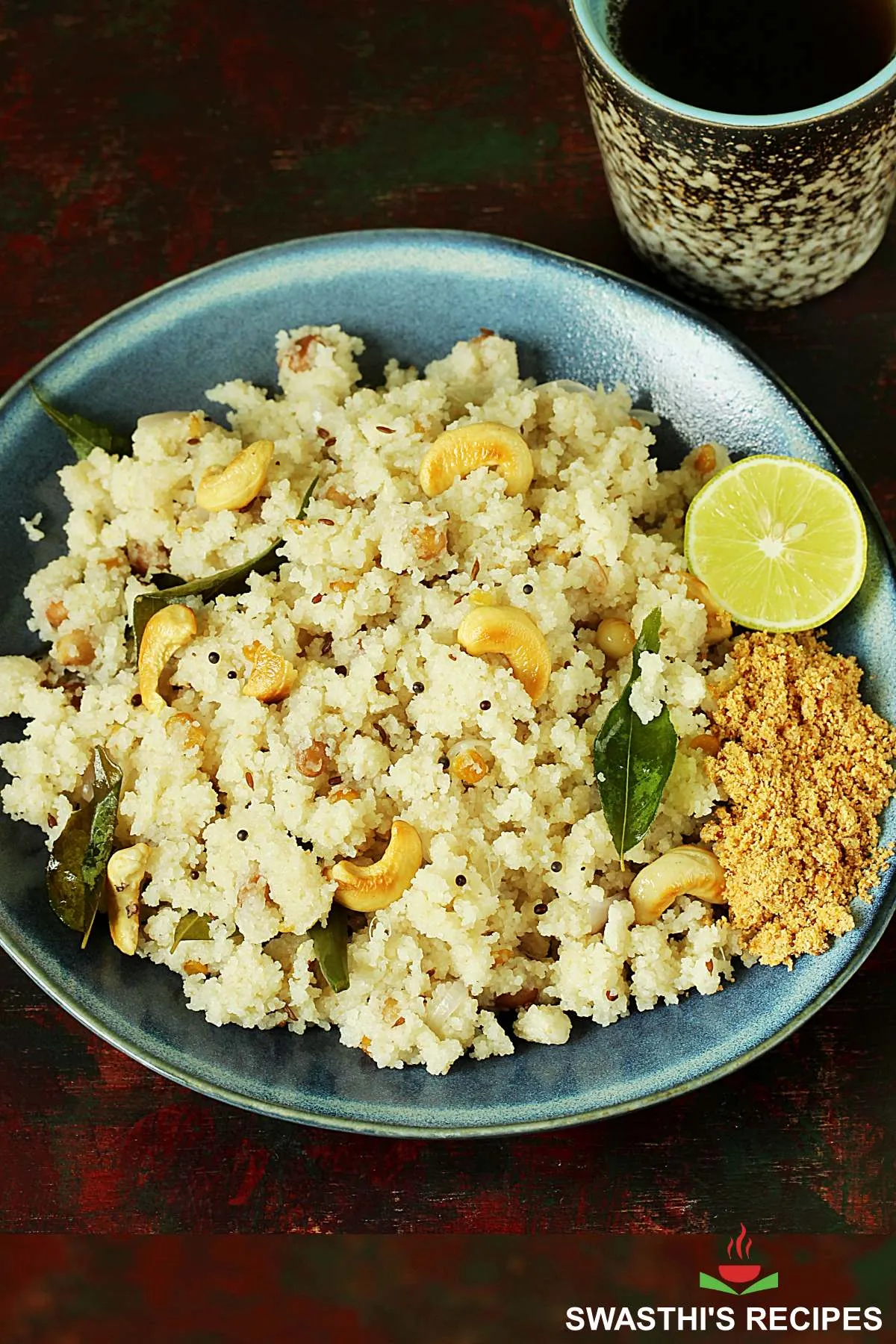
What kind of Rava should I use
Rava is the South Indian name for semolina and is also sold as suji, upma rava or Bombay rava. It is different from semolina flour, bansi rava and dalia (broken wheat). Upma rava is available in 3 varieties – regular (unroasted), roasted and double roasted. If you use regular/ unroasted kind you need to roast as shown in the recipe below.
Double roasted rava has a better shelf life and flavor than the regular rava. It is pre-roasted for you at the manufacturer’s end so you can use it directly in the recipe without roasting again.
Single roast rava (roasted rava) is roasted lightly and most times don’t make the best upma. I prefer to roast the single roasted rava again as it does not give me the desired results like the double roasted.
Ingredients
- Oil/ghee: You can use any cooking oil, ghee or a mix of both. Ghee gives a better flavor to the dish.
- Whole spices: A lot of people use only mustard seeds and do not prefer cumin. However my mom always added cumin seeds for a earthy flavor so I do use them. They also help with digestion. You may omit them if you don’t prefer.
- Fresh ginger imparts a delicious and pungent flavor. Make sure you chop or grate it very fine. You don’t want to bite into the ginger while enjoying your upma.
- Onion and green chilies impart sweet and spicy flavors. A lot of people also use dried red chili (Karnataka style).
- Lentils: You will use split skinned black lentils (split white urad dal) and chana dal (Bengal dal). They add a nutty aroma and crunch to your upma. However if you roast them too long on a low heat, they will remain hard. So make sure you fry them just until golden and aromatic.
- Hing also known as asafoetida is a tree resin and smells funny but once it gets tempered it adds a beautiful flavor to your dish. You may omit it if you don’t like.
Time Saving Expert Tip
I usually roast the whole pack of semolina when I cut it open. Cool it completely and store in a clean air tight jar. This cuts down your roasting time whenever you want to make upma. Plus this step keeps your semolina fresh for longer.
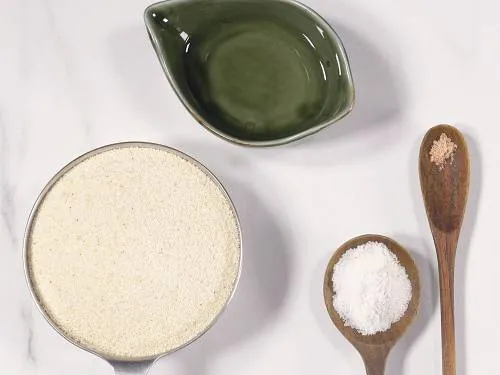
More Upma Varieties
Semiya Upma
Aval (Poha) Upma
Oats upma
Bread upma
Tomato upma
Idli upma
Photo Guide
How to make Upma (Stepwise Photos)
Preparation
1. Clean 1 cup semolina (Bombay rava). Add it to a pan and roast on a low to medium heat until it turns crunchy. Keep stirring to prevent discoloring. We don’t want the rava to brown. If you are using double roasted semolina, then roasting takes only a minute. When it is crunchy set aside to cool.
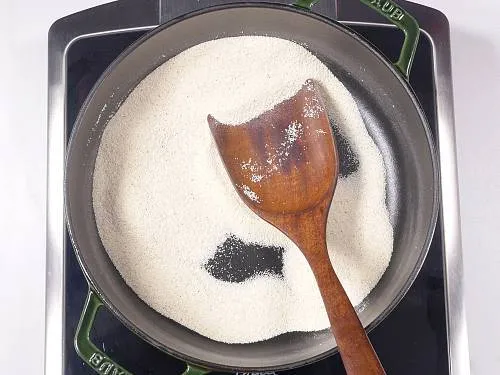
2. While you roast the rava, prepare the following:
- 1 small onion (slice or fine chop)
- ½ inch ginger (½ to ¾ teaspoon fine chopped)
- 1 to 2 green chilies (chopped or sliced)
- 1 sprig curry leaves (rinse and pat dry to avoid splatters)
- If you like to add vegetables you may add ¼ cup green peas, ¼ cup fine chopped carrots and 2 French beans. Ensure they are fine chopped else they won’t cook well.
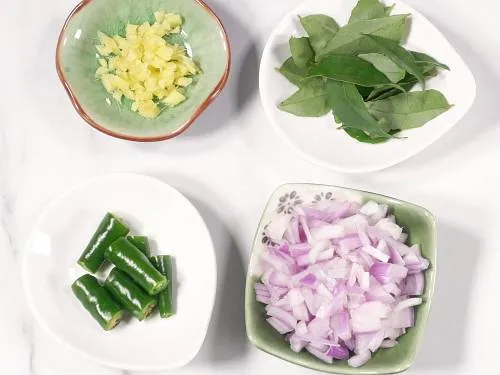
3. To temper you will need
- ½ teaspoon mustard seeds
- ½ teaspoon cumin seeds (Jeera, optional)
- 1 teaspoon urad dal (skinned black gram whole or split)
- 1½ teaspoon chana dal (bengal gram)
- 2 tablespoons peanuts (optional – raw or roasted)
- 8 to 12 whole cashews (split them, you may leave out if using peanuts)
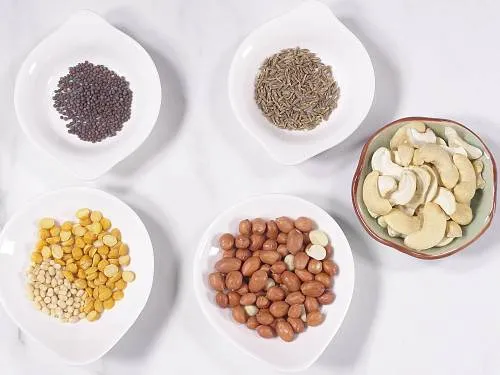
4. Using peanuts is optional and may use if you want a crunch in your upma. On a medium heat, fry the raw peanuts in 1 teaspoon oil until deep golden and aromatic but not burnt. Later remove to a plate and set aside to garnish. Skip this step if using roasted peanuts.
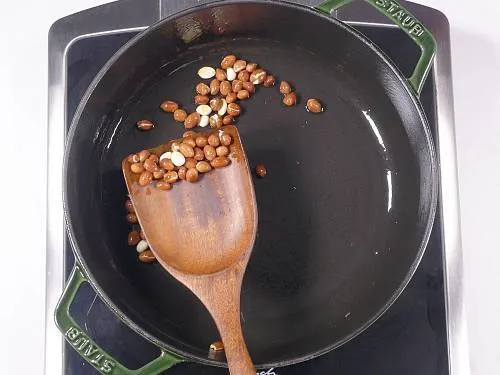
Temper Spices
5. Pour 2 tablespoons oil to the hot pan. When the oil becomes hot, add the mustard seeds and cumin seeds if using. When the seeds splutter, add urad dal & chana dal.
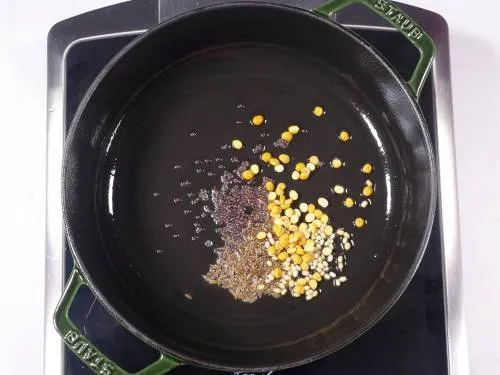
6. Fry them until light golden for a minute, then add the cashews & fry until the cashews turn golden and the lentils turn light brown.
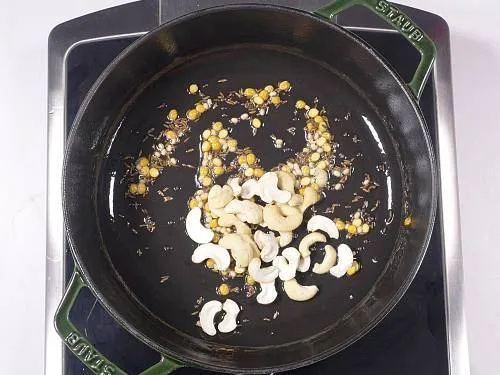
7. Next goes in 1 pinch hing (optional), chopped green chilies, chopped ginger & 1 sprig curry leaves. Fry for a minute until the ginger turns fragrant & the curry leaves turn crisp.
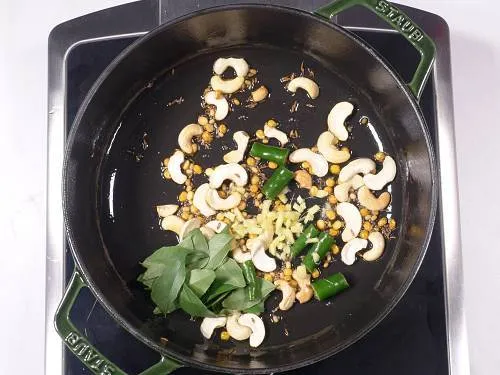
8. Then add 1 small chopped onion.
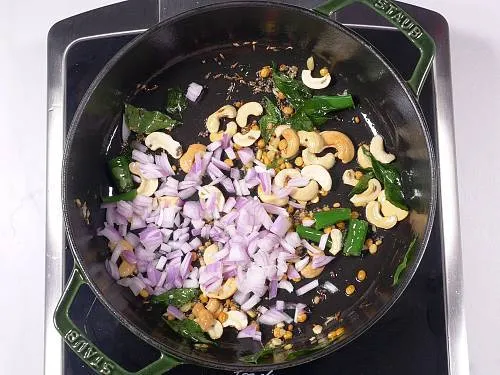
9. Saute just for 3 to 4 mins, until the onions turn transparent.
Optional: If using veggies, you can add green peas, carrots & French beans. Cover and cook on a low heat until the veggies turn slightly tender.
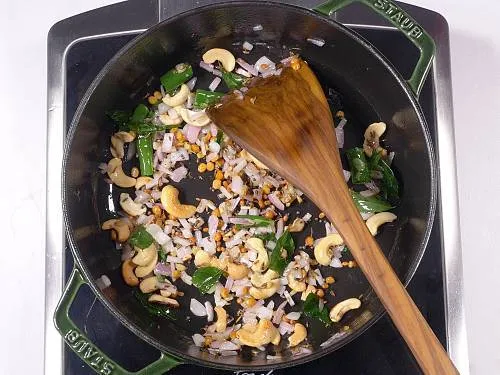
Make Rava Upma
10. Pour 3 cups water and add ½ teaspoon salt. (Use 2¾ cups for a drier upma). Mix it well and taste the water. The water should be slightly salty. If needed add more salt. If you are using a cast iron pan, use up to 3 cups water.
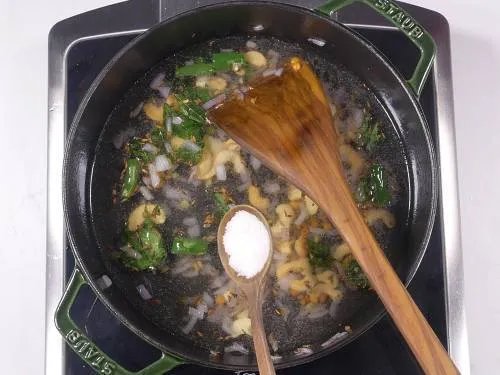
11. Bring the water to a rolling boil on a medium to high flame, then reduce the flame to low heat.
12. Pour the roasted rava in a very slow stream with one hand and constantly stir the water with the other hand. This incorporates the rava well to the water without turning lumpy. (check the video if you are a beginner). Make sure the water is still boiling well while you add the semolina.
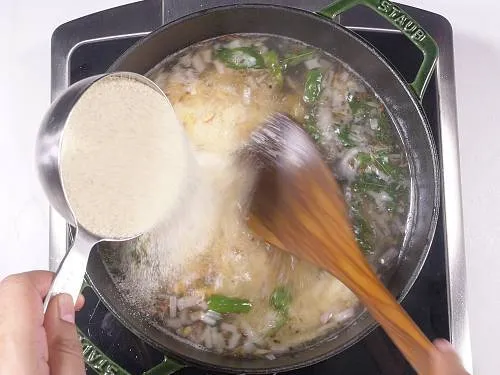
13. Stir well and check for any lumps. Break up if any. Be cautious & quick at this moment, as it begins to splash.
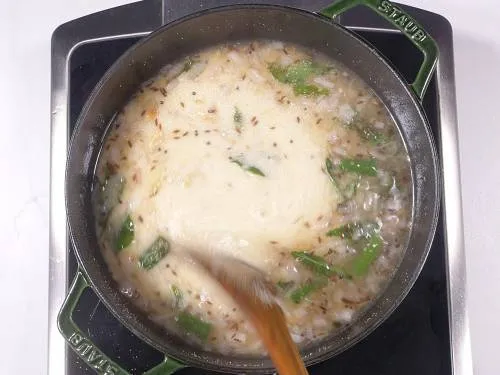
14. You will see all of the water is absorbed. Then cover and cook.
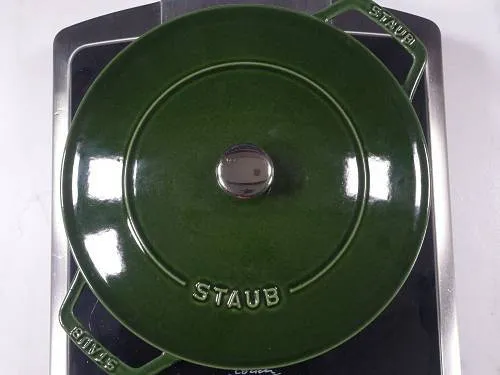
15. After 2 to 4 mins, open and stir the rava upma.
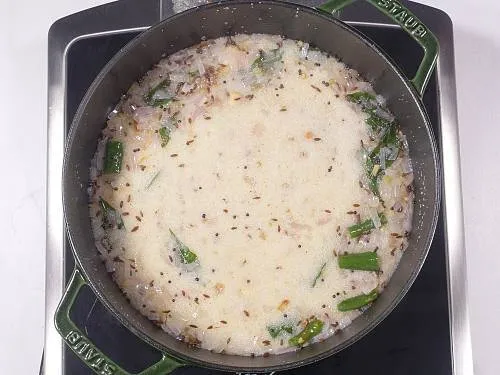
16. Lastly add ghee at this stage. This is optional. Switch off and keep the pan covered for about 5 mins.
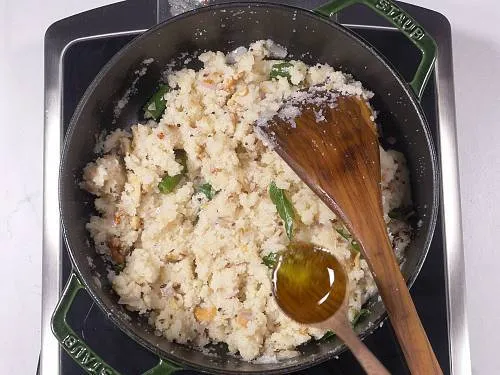
17. Let the upma cool down a bit. You can add fresh grated coconut if you like. It will still look clumpy while hot.
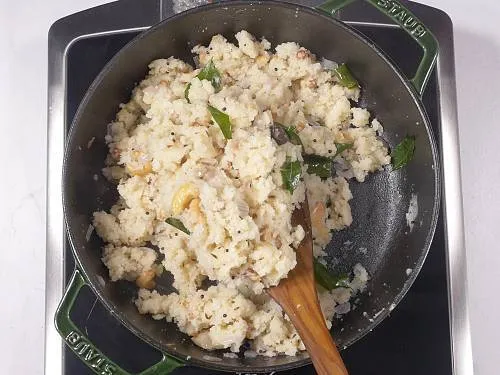
As it cools down, upma begins to look fluffy. Sprinkle lemon juice while serving. Do not squeeze the lemon when it is very hot. Garnish with fried/roasted peanuts if you want. If you feel your upma is dry, it means your semolina may require more water. Next time try with 1:3 ratio.
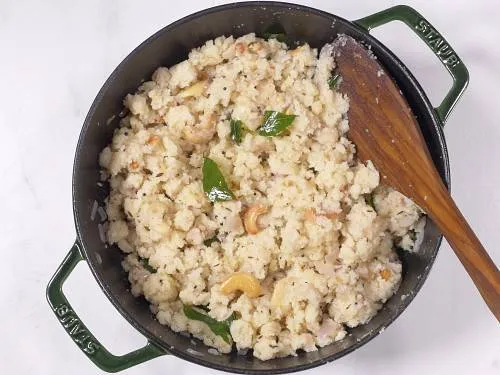
Serve upma with peanut podi, flaxseed podi, coconut chutney, pickle, papad or sambar. As the rava upma cools down, it becomes fluffy and won’t be mushy.

Expert Tips
- Rava & water proportion: This recipe will yield you fluffy upma that is not porridge like or sticky. I know some people who love this like a thick porridge. If you like it that way, you can use about 4 cups of water for 1 cup rava.
- Upma when made in small quantity ex- ½ cup rava usually absorbs upto 1½ cups water (1:3). When you make in large quantity, 1 cup and above use 2¾ to 3 cups water per 1 cup of rava. If you are using a cast iron pan, use 3 cups. There are different kinds of rava, semolina with a little bran takes up fully 3 cups of water and more refined semolina takes up only 2.5 cups. So use accordingly next time.
- Adding rava in a slow stream: Ensure you keep stirring the water constantly in the pot with your right hand while you pour the rava with your other hand. This incorporate the rava well into the water avoiding lumps.
- Quantity of oil: Do not reduce the amount of oil mentioned in the recipe. Using a good amount of oil prevents the upma from turning sticky.
- To make smooth & soft upma like the Karnataka restaurants, use 4 tbsps ghee or oil and 4 cups of water for every cup of rava. Also increase the tempering ingredients proportionately. This serves 4.
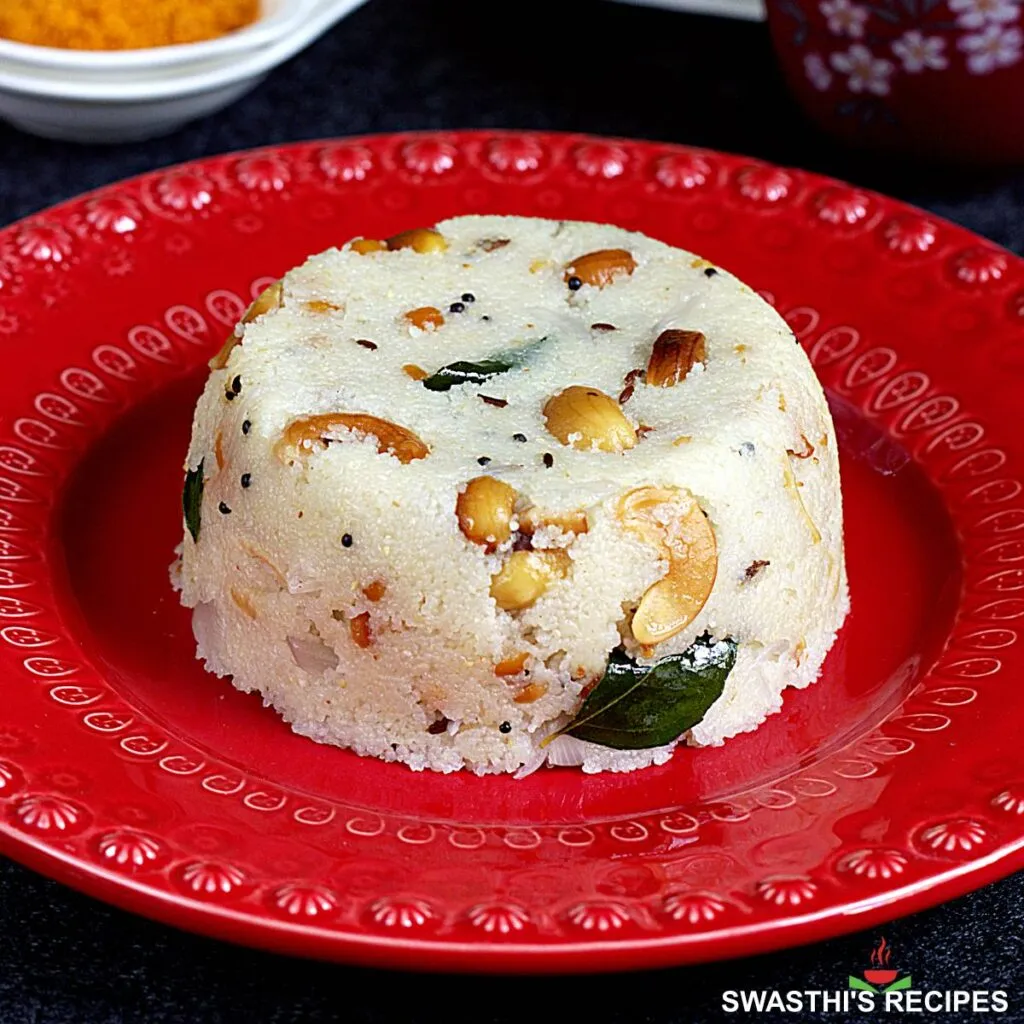
Related Recipes
Recipe Card
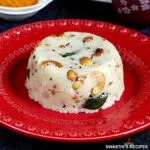
Upma Recipe (Andhra style Rava Upma)
For best results follow the step-by-step photos above the recipe card
Ingredients (US cup = 240ml )
- 1 cup Rava (Bombay rava/ sooji/semolina)
To Temper
- 2 tablespoons oil or ghee (refer notes)
- ½ teaspoon mustard seeds
- ½ teaspoon cumin seeds (jeera, optional, adds aroma)
- 1 teaspoon split urad dal (skinned split black gram)
- 1½ teaspoon chana dal (optional, adds nice aroma, Bengal gram)
- 2 tablespoons peanuts (optional)
- 8 to 12 cashews (you may leave out if using peanuts)
- 1 sprig curry leaves
- 1 pinch asafoetida (hing) (optional)
other ingredients
- ¼ cup onion (chopped or sliced thinly)
- 1 to 2 green chili slit
- ½ inch ginger (½ to ¾ teaspoon very finely chopped or grated)(optional)
- 3 cups water (2¾ cups for a drier upma)
- ½ to ¾ teaspoon salt
- 2 teaspoon ghee (optional)
- lemon juice (optional) to serve
Optional
- ½ cup mixed vegetables (fine chopped carrots, beans and green peas)
Instructions
- Roast rava: On a medium heat, dry roast rava in a pan, stirring often until crunchy and aromatic. Do not brown it. Remove to a bowl and keep aside to cool down.
- Optional – Roast peanuts to garnish – Fry peanuts in 1 teaspoon oil until golden, aromatic and crunchy. Reserve aside to garnish.
- Temper the spices: Pour oil to the hot pan & add mustard seeds, cumin seeds, urad dal & chana dal. Fry until the dal turns light golden. Add cashews and fry until they turn golden & aromatic. Stir in hing, green chilies, ginger and curry leaves.
- Saute for a minute & add chopped onions. Saute until transparent & add mix vegetables (optional) if using. Stir and cook covered until slightly tender.
- Boil water: Pour water and add salt. Mix and taste test the water. It has to be slightly salty. If required add more and bring the water to a rolling boil.
- Make upma: Lower the heat. With one hand pour rava in a slow stream to the boiling water, while you incorporate it into the water with the other hand. (check video). Be quick at this stage. Stir everything once to check any lumps. Break up if any.
- Cover and cook on the lowest flame until the water is completely absorbed. This just takes 2 to 4 mins depending on the kind of pot or pan used. Add ghee and give a quick stir. Turn off and cover back to rest for 5 mins.
- Stir in the lemon juice and serve rava upma plain or with spiced peanut podi, chutney, pickle or curd. Garnish with roasted/fried peanuts.
Video
NUTRITION INFO (estimation only)
© Swasthi’s Recipes
About Swasthi
I’m Swasthi Shreekanth, the recipe developer, food photographer & food writer behind Swasthi’s Recipes. My aim is to help you cook great Indian food with my time-tested recipes. After 2 decades of experience in practical Indian cooking I started this blog to help people cook better & more often at home. Whether you are a novice or an experienced cook I am sure Swasthi’s Recipes will assist you to enhance your cooking skills. More about me
Follow Swasthi’s Recipes

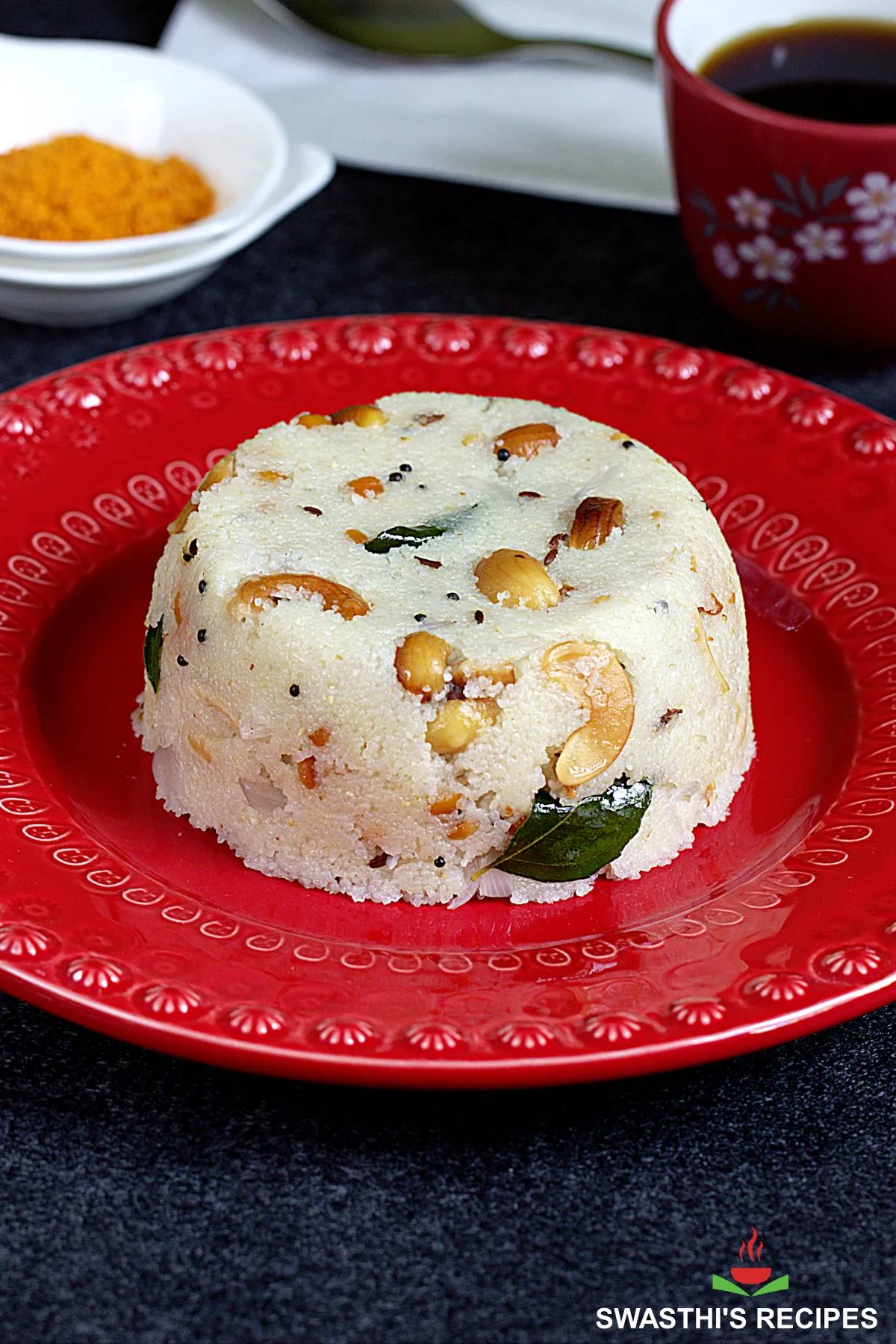
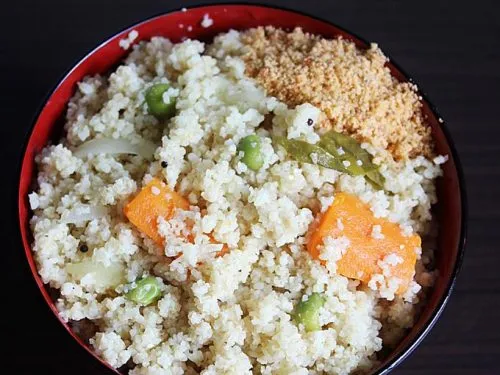
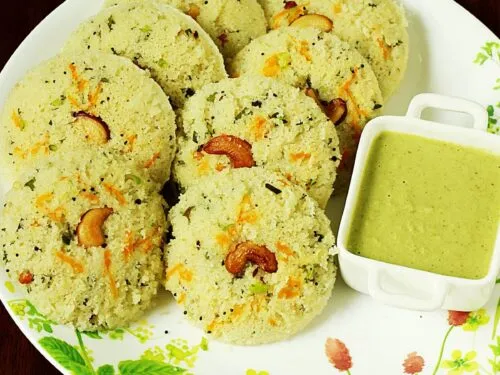
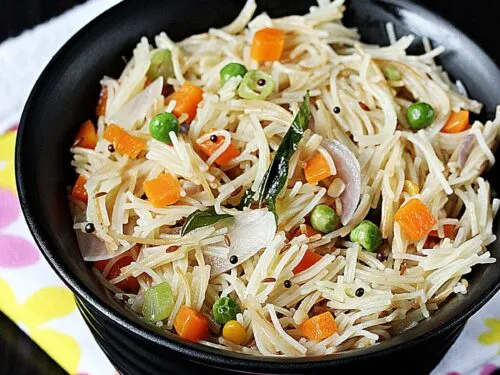
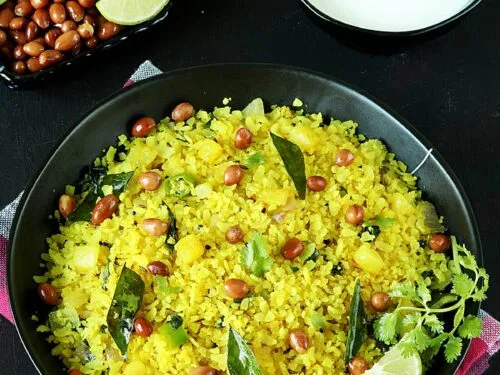
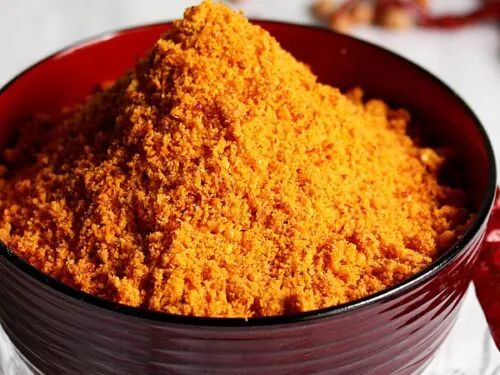
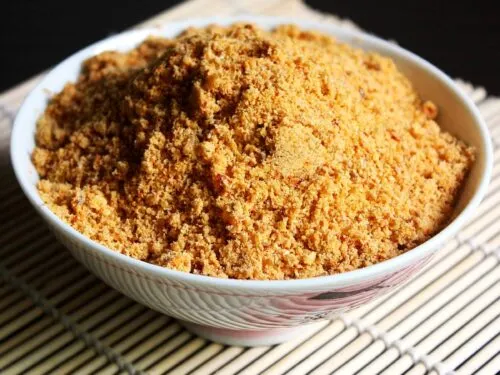
Comments
I have been following this recipe for 2 years and comes out perfect every time. I use 3.5 cups water for a more soft and moist upma. Thank you and keep up the good work
Thanks Jaidev. Glad to read that
Loved the flavors of this recipe. I made a gluten-free version using Millet and Amaranth in the instant-pot, and that worked out rather well. I posted the details on my tumblr, but seems like I can’t copy that link here. Anyway, thank you very much.
Glad to know Gauria. Thank you for sharing back
Tried this upma recipe for the first time and it came out delicious. Next time I would add more ginger and vegetables.
Best recipe and well explained…loved it
I visited Rameswaram. A great pleasure, we can find the south food. The bannana leaves plate brings a life and taste. The use of coconut means the elixir on the food. A great food a great south!!
I have made upma for years but this takes it to a new level. Thanks for sharing
So glad you like it Nirmal. Thank you
This recipe is great. It’s the closest thing I can find to my mom’s
“recipe.” My son loves it for school lunch. I add in a little extra dal and cashews for protein.
I cook this recipe on a regular basis (nearly every week) and it never let’s me down. It’s very hearty and filling.
Tried this recipe for the first time and came out great!
Thanks for sharing
simple steps, easy to make and very tasty!
Turned out beautifully! Thank you for posting
My frequent go to breakfast on busy mornings. Very very easy and simple to make. Thanks for the recipe
How nicely explained with all the subtle nuances of rawa cooking.
Thank you Sunita
Amazing five star recipe. My family loved it, Have tried your other recipes and they were delicious too. congrats Swasthi.
The Upma was delicious. Thanks for sharing your yummy recipes
When I make upma with sunflower oil a smell comes from it.How can Ifix it next time.
Priti,
I guess you are using unrefined sunflower oil. Actually tempering process for upma takes about 5 minutes and heating unrefined oils for so long without a wet/moist ingredient may not be good. Try using half ghee and half oil. Hope this helps.
Thank You! Best upma recipe
Thank you for the detailed recipes. I made this upma for 2 years and it always worked out. But somehow it turns out dry for the last few times. I tried adding more ghee but that’s a lot of ghee. What am I doing wrong?
Hi Chaitanya,
It is the kind of rava. Usually organic and coarse rava has more bran in them and require more water. Try using 3 cups. Thanks for bringing this up. I have updated the same in the recipe for your future reference. Hope this helps.
Don’t you use garlic for Upma?
No Garlic. Use only ginger
Delicious upma! Tried it for the first time and loving it. I’m wondering if the lentils are supposed to be soft in the upma because mine remained slightly crunchy. Is that okay?
Yes they are supposed to remain slightly crunchy but not hard. If you want them fully soft, pour 1/4 cup more water and let the tempering cook for 5 minutes before you add the rava. Hope this helps
The best uppuma recipe..so easy and taste is absolutely delicious!!
Thanks Tina